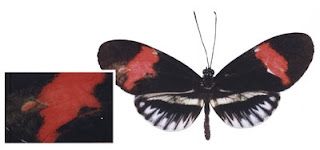Week 6 BioTech + Art
BioArt is an art practice where artists work with live tissues, bacteria, living organism, and life processes. The artworks are produced in laboratories, galleries, or artists' studio using scientific processes such as biotechnology. Even though BioArt has drawn attention to ethical issues, it is still a good example that life itself is a valid expressive medium. As an engineering student, I have taken life science course so I am quite familiar with the topics about transgenics, mutilation, mutation, recombinance or selective breeding. I would easily relate these topics to the scientific field but not artistic field. After viewing this week's materials, I realized that they are pretty similar if artistic medium follows the standards in manipulating living organisms and semi-living systems.
Heliconius Melpomene butterfly, one wing has a "natural design", whereas the patterns on the other has been artificially modified
The artist Stelarc reveals the current state of his ongoing "Ear on Arm" project
References
In Lecture Part 1, Professor Vesna gave an example how people reacted when transgenics was used in the scientific field and artistic field. When scientists inject glowing genes into animal cells for research purposed to provide animal models for studying biological processes and diseases. Scientists who work with the fluorescent proteins have pretty dismissed the project as interesting but silly. However, when the same project was done by an artist named Eduardo Katz to create a new art form based on the use of genetic engineering to create unique living beings, animal right activists claim that the project is needless and abusive manipulation of an animal. This is about how we define and value artistic media and technologies. It seems that, at the expense of living beings, using biotechnologies such as transgenics in art offers fewer benefits.
"GFP Bunny": a transgenic artwork that comprises the creation of a green fluorescent rabbit ("Alba")
However, in Chris Kelty article, he stated that creativity comes from creativity. As a result, the restrictions should not be more or less stringent for artists using biotechnology than for scientists in industry. According to Ellen K. Levy, art also has the capacity to reveal new things in our technology. There is not need for separate standards for artists creating or manipulating living organisms and semi-living systems. Biotechnology has different meanings and values for both art and science.
The artist Stelarc reveals the current state of his ongoing "Ear on Arm" project
References
Dayal -Wired, Geeta. "For Extreme Artist Stelarc, Body Mods Hint at Humans' Possible Future." Io9. Io9.gizmodo.com, 21 May 2012. Web. 14 May 2017.
Levy, Ellen K. “Defining Life: Artists Challenge Conventional Classifications.” DESMA 9. Web.14 May 2017.
Kelty, Chris. “Meanings of Participation: Outlaw Biology?” (n.d.): 1-8. DESMA 9.Web. 14 May 2017.
Vesna, Victoria. "5 bioart pt 1 1280x720 ." YouTube, uploaded by Uconlineprogram, 13 September 2013, www.youtube.com/watch?v=PaThVnA1kyg.
Stracey, Frances. "Bio-art: the ethics behind the aesthetics." Curr. Biol 12 (2002): 347-358.





I think that no separate standards for artists creating or manipulating living organisms and semi-living systems would definitely increase the creativity in biology. However, how do we know that the artists have the adequate knowledge in biology to do so? We have read in lecture that sometimes, this can lead to creation of a butterfly with holes in the wind too.
ReplyDelete